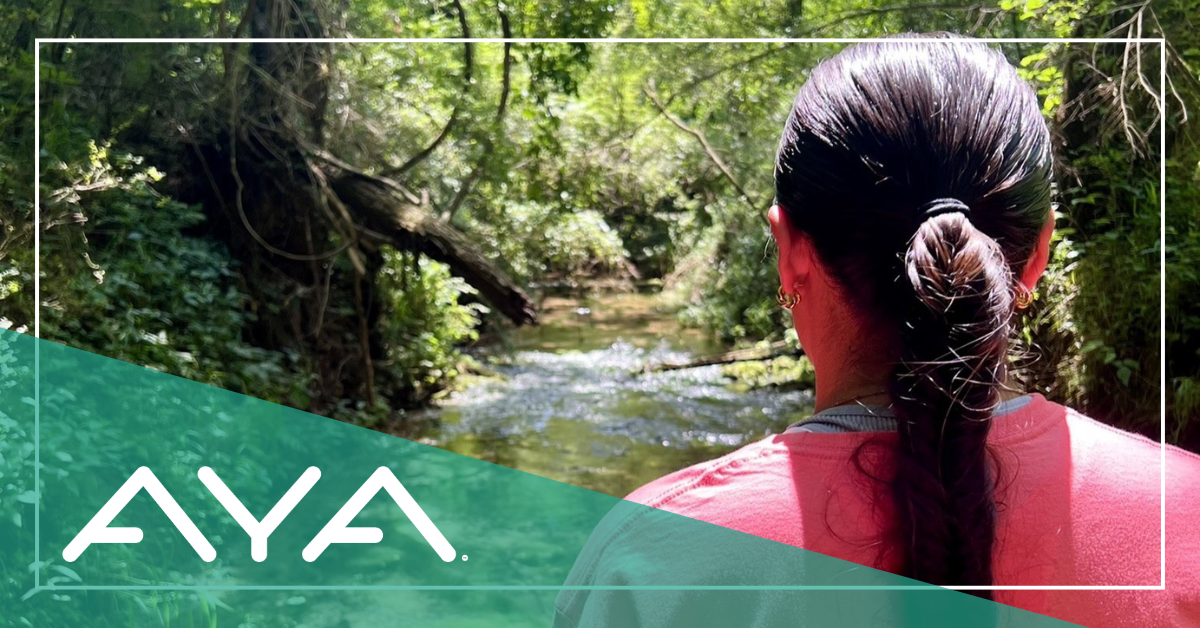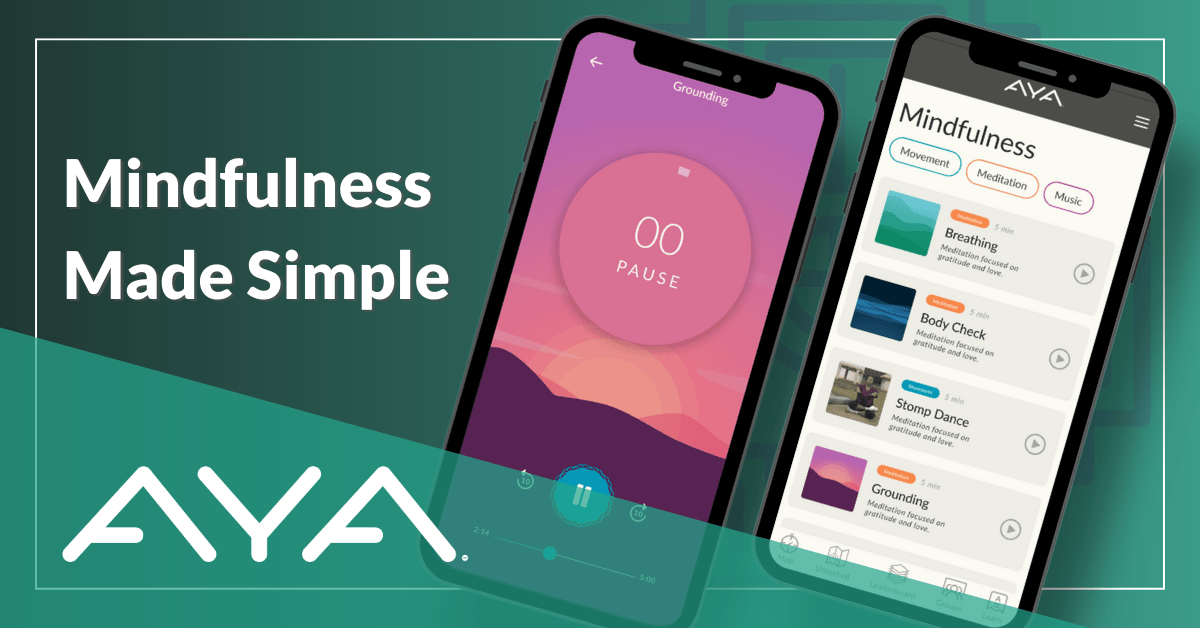Mental Clarity Through Meditation
Meditation offers a powerful pathway to relaxation and inner peace. Through this practice, you gain the ability to calm your mind, settle your nerves...

Have you ever felt refreshed after a walk in the park or noticed how your mood lifts when sunlight streams through your window? There is a reason for that. Research shows having a positive connection to nature promotes emotional, psychological and physical well-being. Your connection with nature directly impacts your health, and AYA is here to help you strengthen that bond.
Just minutes of nature connection can transform your day with benefits including:
In this guide, you will discover exactly what a connection to nature means, how to experience it regardless of your living situation and how AYA makes this tool accessible to everyone. By the end, you will have a personalized plan to harness nature's healing power in ways that fit your lifestyle.
One common misconception prevents many people from connecting with nature: the belief that it only exists in remote wilderness areas. In reality, nature means the external world in its entirety, and it is all around you. Nature can range from national parks to things you can find right at home or outside your window. You do not need mountains or oceans to benefit from nature connection – these everyday elements count too:
The key insight? Nature is not limited to remote wilderness – it exists all around us, even in the most urban environments. Recognizing this immediately opens possibilities for connection, no matter where you live.
Now that we understand what counts as nature, what exactly does it mean to "connect" with it? And why does this connection matter so deeply for your well-being?
According to the Mental Health Foundation, "connectedness refers to the way we relate to and experience nature." A good way to conceptualize connectedness is through familiar parallels in your life. Think about how you relate to things you love:
Being connected to nature works the same way. It means developing a meaningful emotional relationship with the world around you. This connection might manifest in ways such as:
The transformative news? This healing connection is accessible to everyone, regardless of where you live. Thankfully, with a little intention and the right approach, this powerful relationship with nature is possible even if you live in the heart of a bustling city.
Before we dive into how to deepen your nature relationship, it is worth celebrating the ways you might already be connecting without realizing it. Many people assume that meaningful nature connection requires hiking remote trails or camping under stars, but the reality is much more accessible.
Consider what a positive connection to nature looks like in everyday life. The ways we connect to nature are wonderfully diverse. You are already connecting with nature when you:
These examples reveal an empowering truth: connecting with nature does not have to be complicated or time-consuming. You do not even need to be physically immersed in nature to benefit from it. You are already building this connection when you watch a documentary about the rainforest or simply notice sparrows tweeting in your yard!
The beauty of a connection with nature is you can begin exactly where you are right now – no special equipment, locations or prior experience needed.
We recommend two complementary approaches that work for anyone, anywhere. Each offers immediate benefits while building toward a deeper nature relationship:
These practices support each other and create a positive cycle of benefits.
Nature appreciation is your gateway to deeper connection – the perfect starting point for everyone. This approach requires no special skills or major time commitments. Instead of focusing on distant wilderness experiences, we will help you discover nature exactly where you are.
This is an easy, entry-level way to grow your connection with nature. Remember, it is not necessary to go on a 10-mile hike in the middle of nowhere. While this is one way to develop your appreciation for nature (and your survival skills), for many, it is not practical.
To appreciate something means you value it for its worth, usefulness or beauty. Nature in all its forms is truly a masterpiece of creation. This viewpoint helps us open the path to developing appreciation – no matter where we live.
Choose the approach below that best matches your living situation:
If you reside in an urban area like a big city or a place with a high population density, start small and work your way out. When you walk around the city or stroll down sidewalks, look for any sign of nature such as a tree near a crosswalk, a plant poking out of an upstairs window or an interesting cloud shape.
This does not have to take long. You can notice one or two things about nature around you and go on with the rest of your day. Whatever you do, remember to pause for a moment of appreciation or say a word of appreciation in your head. That was a tall tree. I wonder how long it has been there? Or I liked seeing that potted plant in the window. It brightened my day.
A step up from urban areas are outdoor areas. These places have nature appreciation built in. Think of city parks, walking trails, hiking trails, state parks, national parks and country roads.
This form of nature appreciation will be less spontaneous. You may have to plan but the rewards will be worth it. As part of the planning, consider what you would like to gain from the experience. Think, what can I notice about nature I have never noticed before? Or what are three things I can find to love about my surroundings?
The last example of nature appreciation is two-sided. In one sense, this may be the easiest form of nature appreciation on the list. For others, it may require the most work and commitment. A few ideas include the following:
In addition to nature appreciation, you can also consider outdoor mindfulness. In its simplest terms, mindfulness is being intentional, deliberate and in the moment. It is a sense of nonjudgmental awareness of all you are thinking mentally, feeling emotionally and sensing bodily.
Nature appreciation fits perfectly with mindfulness. First, the outdoors often encourages a sense of reflection. Nature has a way of bringing out awe. Second, nature has lessons to teach us about change and awareness. The leaves change in the fall, the rain falls steadily with the wind and the sun rises each day.
Outdoor mindfulness can also be practical. So, if you are more into the idea of doing something in the great outdoors, there are many options. Here are a few ways you can practice outdoor mindfulness:
AYA is here to support and enhance your mindfulness journey. We have designed features specifically to deepen your nature connection and maximize the well-being benefits you experience. Our newest mindfulness tools include:
These features are designed to be enjoyed both indoors and outdoors, allowing you to combine the benefits of mindfulness with nature appreciation. For step-by-step guidance on using these features, visit our mindfulness guide. To learn more about these benefits, read our Move, Breathe, Meditate blog.
Beyond our dedicated mindfulness tools, AYA offers rich nature connections throughout the app experience:
These elements work together to enhance your nature appreciation practice while connecting you to cultural wisdom about living in harmony with the natural world.
It is completely normal if this approach to nature feels new to you. Creating a positive connection might even seem intimidating or strange at first. Remember that the most powerful benefits often come from the simplest practices, consistently applied. Here is your five-step plan to get started today:
A positive connection to nature is one of the most accessible ways to improve your well-being. These simple practices, enhanced by AYA's thoughtful features, can reduce stress, improve mood and create moments of joy in your day. Nature is waiting for you – and the path to better well-being has never been more accessible.
Anowa chipisala'cho (until we meet again),
- The AYA Walk Team
References
18 mindfulness activities for Outdoors. The Pathway 2 Success. (2020, June 17). https://www.thepathway2success.com/18-mindfulness-activities-for-outdoors/
A, N. (2024, August 24). How to enjoy nature if you’re not a “nature person.” Medium. https://medium.com/for-our-good/how-to-enjoy-nature-if-youre-not-a-nature-person-a10543b58205
Laura. (2022, January 19). Simple steps to start a garden (for the beginner). This House of Dreams. https://www.thishouseofdreams.com/simple-steps-to-start-a-garden-for-the-beginner/
Mastro, M. (n.d.). 38 low-maintenance indoor plants that won’t require your constant attention. The Spruce. https://www.thespruce.com/low-maintenance-indoor-plants-8622418
Merriam-Webster. (n.d.). Nature definition & meaning. Merriam-Webster. https://www.merriam-webster.com/dictionary/nature
Nature: How connecting with nature benefits our mental health. Mental Health Foundation. (n.d.). https://www.mentalhealth.org.uk/our-work/research/nature-how-connecting-nature-benefits-our-mental-health
Noll, M. (2024, March 26). How to make a DIY indoor compost bin. Better Homes & Gardens. https://www.bhg.com/gardening/yard/compost/diy-indoor-compost-bin/
Spoonemore, C. (2025, January 26). Indoor Gardening for beginners: An ultimate guide. Park Seed. https://www.parkseed.com/blog/indoor-gardening-for-beginners-an-ultimate-guide
The AYA Walk App is a one-of-a-kind step counter that offers an exciting way to discover captivating narratives as you go about your daily routine.
The word "AYA" originates from the Chickasaw language and signifies "to go; to journey." As you take steps towards improving your fitness, AYA Walk accompanies you on this adventure, guiding you through time and unlocking stories from the past.
Along the way, you will stumble upon hidden treasures rooted in Chickasaw heritage, discover historical paths that unveil the secrets of the past, and have the chance to listen to stories about significant cultural landmarks.
AYA Walk celebrates more than just physical well-being; it also fosters a renewed connection to a healthier lifestyle. By engaging with this innovative step tracker, you'll improve your fitness and gain a deeper appreciation for the stories surrounding us.
Download AYA Walk today!

Meditation offers a powerful pathway to relaxation and inner peace. Through this practice, you gain the ability to calm your mind, settle your nerves...

Discover how simple breathing exercises can reduce stress, improve focus and enhance your overall well-being in just minutes a day.

1 min read
Your Step-by-Step Guide to Getting Started with AYA's New Mindfulness Feature To enjoy AYA's new Mindfulness Feature and start your journey towards...